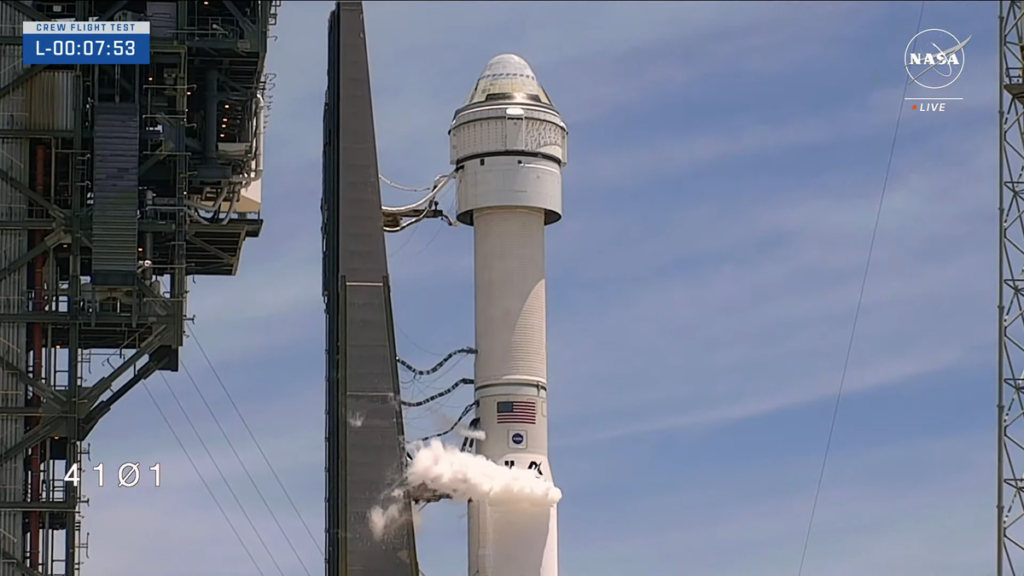The first crewed launch of Boeing’s Starliner spacecraft has been delayed until no earlier than June 5 after an automatic abort cut short an attempted flight Saturday afternoon just minutes before liftoff.
Boeing’s Starliner spacecraft and its Atlas V rocket were less than 4 minutes away from launching two NASA astronauts to the International Space Station (ISS) today, June 1, from Cape Canaveral Space Force Station in Florida at 12:25 p.m. EDT (1625 GMT) when the abort occurred. A ground launch sequencer (GLS) computer triggered the automatic abort 3 minutes and 50 seconds before liftoff, but the exact cause is still unclear.
“It’s disappointing,” NASA commercial crew program manager Steve Stich said in a press conference after the launch scrub. “Everybody’s a little disappointed but you kind of roll your sleeves up and get right back to work.” The delay means Starliner’s astronaut crew, NASA’s Butch Wilmore and Sunita Williams, must wait nearly another week to fly.
NASA, Boeing and Atlas V rocket builder United Launch Alliance did have an opportunity to launch the Starliner flight on Sunday (June 2), but they decided to skip that window to better understand the cause of Saturday’s abort.
“NASA, Boeing, and ULA (United Launch Alliance) are forgoing a Crew Flight Test launch attempt Sunday, June 2, to give the team additional time to assess a ground support equipment issue at Cape Canaveral Space Force Station’s Space Launch Complex-41 in Florida,” NASA wrote in a mission update sent to reporters Saturday evening.
ULA CEO Tory Bruno told reporters in the post-scrub briefing that engineers suspect the abort may have been caused by a faulty computer card in the ground launch sequencer system housed in a building at the base of Starliner’s launch pad, Launch Complex-41, at Cape Canaveral Space Force Station. But checking that card would require ground teams to wait several hours until it was safe to approach the pad. “The system was unsuccessful in verifying the sequencer’s necessary redundancy,” NASA officials said of the sequencer glitch.
“We can’t get in there until we’re done defueling a rocket, which is followed by making sure there’s no stray hydrogen inside that building, so that it’s safe for people to be there. Then we’ll go in and troubleshoot it, Bruno said. “And if it’s as simple as replacing a card, we have spares for everything, and we would do that. We would test it, which is required, and then be in a position for a recycle tomorrow.”
“If it’s more involved than that, or it just takes longer to get through all of that,” then the backup dates on June 5 or June 6 would have to be looked at as a possibility. Shortly after the briefing, NASA officials announced that the next launch try would occur no earlier than June 5.
A liftoff on June 5 would occur at 10:52 a.m. EDT (1452 GMT), with NASA’s webcast expected to start about four earlier. You can follow our Starliner launch live updates for the latest details and watch the Starliner launch online via our NASA TV simulcasts.
Starliner, Boeing’s contribution under a $4.2 billion contract with NASA’s Commercial Crew Program, has been plagued with delays, both over the past few years, and also in the last several weeks as the spacecraft’s Crewed Flight Test (CFT) has now attempted and failed to get off the ground two times.
A May 6 attempt was scrubbed due to issue with the valves in the launch vehicle’s Atlas Centaur upper stage. That setback forced mission operators to roll the rocket back to ULA’s Vertical Integration Facility for repairs.
Today’s countdown experienced some hiccups of its own. Valve communication issues with Atlas V’s ground systems was temporarily lost about two hours before the scheduled liftoff, and, as the countdown ticked down to within minutes before liftoff, Wilmore reported a fan warning light in his spacesuit with less than 11 minutes to launch. Both glitches were resolved in time for the launch attempt.
After June 5, Starliner also has one more backup launch date on June 6 before ULA and Boeing would have to stand down for 10 days or so to swap out vehicle batteries, Boeing officials have said.
Source: https://www.space.com/boeing-starliner-astronaut-launch-abort-minutes-before-liftoff



